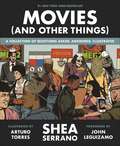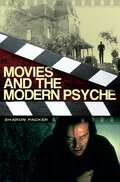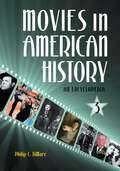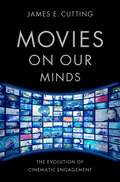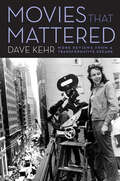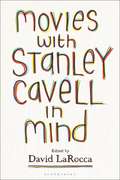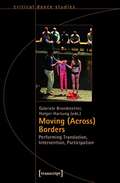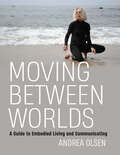- Table View
- List View
Movie Stunts & Special Effects: A Comprehensive Guide to Planning and Execution
by Andrew LaneThroughout film history, one of the fundamental fantasies portrayed on screen has been the kind of physical action few of us could ever experience in real life. The image of an 'every man' engaged in hand-to-hand, mortal combat, defending his family or even the world population against an overwhelming and malevolent force, speaks to our most primal instincts and thus became a mainstay of movie entertainment. In order to translate these deep-seated fantasies to the screen, filmmakers have been developing special skills and crafts for over 100 years. It is these skills that make 'movie magic' and have allowed audiences to take part in the primal hopes and fears we all possess. Movie Stunts & Special Effects: A Comprehensive Guide to Planning and Execution is designed to inform filmmakers on how to plan for and utilize these crafts by engaging and empowering filmmakers to better communicate with stunts and effects practitioners, and thereby enabling them to more fully realize their vision. Director/Producer Andrew Lane surveys fights, use of weapons, cars and vehicles, falls, the use of pyrotechnics, atmospheric effects, bullet hits, wounds and blood, among many other categories. Factors such as cost, time to implement, safety accommodations, and assessing the competence of those employed to plan and execute stunts and special effects are numerous and very specific. Each topic in Movie Stunts & Special Effects is examined using narrative explanations and extensive interviews with world-renowned experts. Various stunts and special effects are explored in the context of how they are best captured by a camera and then editorially constituted in the final product.
Movie Stunts & Special Effects: A Comprehensive Guide to Planning and Execution
by Andrew LaneThroughout film history, one of the fundamental fantasies portrayed on screen has been the kind of physical action few of us could ever experience in real life. The image of an 'every man' engaged in hand-to-hand, mortal combat, defending his family or even the world population against an overwhelming and malevolent force, speaks to our most primal instincts and thus became a mainstay of movie entertainment. In order to translate these deep-seated fantasies to the screen, filmmakers have been developing special skills and crafts for over 100 years. It is these skills that make 'movie magic' and have allowed audiences to take part in the primal hopes and fears we all possess. Movie Stunts & Special Effects: A Comprehensive Guide to Planning and Execution is designed to inform filmmakers on how to plan for and utilize these crafts by engaging and empowering filmmakers to better communicate with stunts and effects practitioners, and thereby enabling them to more fully realize their vision. Director/Producer Andrew Lane surveys fights, use of weapons, cars and vehicles, falls, the use of pyrotechnics, atmospheric effects, bullet hits, wounds and blood, among many other categories. Factors such as cost, time to implement, safety accommodations, and assessing the competence of those employed to plan and execute stunts and special effects are numerous and very specific. Each topic in Movie Stunts & Special Effects is examined using narrative explanations and extensive interviews with world-renowned experts. Various stunts and special effects are explored in the context of how they are best captured by a camera and then editorially constituted in the final product.
Movie Towns and Sitcom Suburbs: Building Hollywood’s Ideal Communities (Screening Spaces)
by Stephen RowleyMedia depictions of community are enormously influential on wider popular opinion about how people would like to live. In this study, Rowley examines depictions of ideal communities in Hollywood films and television and explores the implications of attempts to build real-world counterparts to such imagined places.
Moviemakers' Master Class: Private Lessons From The World's Foremost Directors
by Laurent TirardFrom Scorsese and Lynch to Wenders and Godard: interviews with twenty of the world's greatest directors on how they make films - and why. Each great film-maker has a secret method to his moviemaking - and each is different. In Moviemakers' Masterclass, Laurent Tirard talks to an illustrious collection of today's greatest directors to get to the core of their approach to cinema. The results shed a unique light upon the mysteries of the directorial process. Martin Scorsese, we learn, likes setting up each shot very precisely in advance. Lars von Trier, on the other hand, refuses to think about a set-up until the day of filming. And Bernardo Bertolucci tries to dream his shots the night before . . . Other directors featured include Woody Allen, Pedro Almodovar, Tim Burton, the Coen brothers, Jean-Pierre Jeunet and Wong Kar-Wai.
Movies (And Other Things)
by Shea SerranoINSTANT #1 NEW YORK TIMES BESTSELLERWALL STREET JOURNAL BESTSELLERBARNES & NOBLE BESTSELLERAMAZON BESTSELLER"Paging through Serrano's Movies (and Other Things) is like taking a long drive at night with a friend; there's that warmth and familiarity where the chat is more important than the fastest route from Point A to Point B...It's like a textbook gone right; your attention couldn't wander if it tried." -- Elisabeth Egan, New York Times Book ReviewShea Serrano is back, and his new book, Movies (And Other Things), combines the fury of a John Wick shootout, the sly brilliance of Regina George holding court at a cafeteria table, and the sheer power of a Denzel monologue, all into one.Movies (And Other Things) is a book about, quite frankly, movies (and other things).One of the chapters, for example, answers which race Kevin Costner was able to white savior the best, because did you know that he white saviors Mexicans in McFarland, USA, and white saviors Native Americans in Dances with Wolves, and white saviors Black people in Black or White, and white saviors the Cleveland Browns in Draft Day? Another of the chapters, for a second example, answers what other high school movie characters would be in Regina George's circle of friends if we opened up the Mean Girls universe to include other movies (Johnny Lawrence is temporarily in, Claire from The Breakfast Club is in, Ferris Bueller is out, Isis from Bring It On is out...). Another of the chapters, for a third example, creates a special version of the Academy Awards specifically for rom-coms, the most underrated movie genre of all. And another of the chapters, for a final example, is actually a triple chapter that serves as an NBA-style draft of the very best and most memorable moments in gangster movies.Many, many things happen in Movies (And Other Things), some of which funny, others of which are sad, a few of which are insightful, and all of which are handled with the type of care and dedication to the smallest details and pockets of pop culture that only a book by Shea Serrano can provide.
Movies and the Modern Psyche
by Sharon Packer MDBy looking at the interactions between cinema and psychology, Packer offers readers clear and basic insights into some of the most fundamental reasons why film is such an important influence upon our lives today. Movies and the Modern Psyche first describes the basic concepts of psychoanalysis, experimental psychology, behavioral conditioning, and hypnosis, which have all played major roles in the histories of both film and psychiatry. It then goes on to discuss the recent rise in film therapy, drug treatments, treatment for drug abuse, and the closing of asylums, to show how shifts in treatment techniques, theories, and settings are foreshadowed and fossilized by film.Psychology and cinema are kindred cousins, born at the same time and developing together, so that each influences the other. From the mind-controlling villains that occupy early horror films and Cold War thrillers (like Caligari, Mabuse, and The Ipcress File), to the asylums that house numberless political allegories and personal dramas (in Shock Corridor, Spellbound, One Flew over the Cuckoo's Nest, and Girl Interrupted), to the drugs, phobias, and disorders that pervade so many of our favorite films (including, as a small sample, Vertigo, Night of the Hunter, Psycho, Rainman, Fight Club, Requiem for a Dream, and Batman Begins), there is no escaping either psychology in the movies, or the movies in psychology. By looking at the interactions between cinema and psychology, this book offers readers clear and basic insights into some of the most fundamental reasons why film is such an important influence upon our lives today.Movies and the Modern Psyche first describes the basic concepts of psychoanalysis, experimental psychology, behavioral conditioning, and hypnosis, which have all played major roles in the histories of both film and psychiatry. It then goes on to discuss the recent rise in film therapy, drug treatments, treatment for drug abuse, and the closing of asylums, to show how shifts in treatment techniques, theories, and settings are foreshadowed and fossilized by film.
Movies and the Reagan Presidency: Success and Ethics
by Chris JordanThe 1980s were unique in both American history and the history of American cinema. It was a time when a United States president—a former B-movie actor and Cold War industry activist—served as a catalyst for the coalescence of trends in Hollywood's political structure, mode of production, and film content. Ronald Reagan championed a success ethos that recognized economic and moral self-governance as the basis of a democratic society. His agenda of tax reform and industry deregulation simultaneously promoted the absorption of Hollywood's major studios into tightly diversified media conglomerates, and concentrations of ownership promoted the production and release of movies with maximum revenue potential. Indeed, the most commercially successful movies of the decade put forth the ideologies of WASP America, nuclear family self-sufficiency, and conspicuous consumption.Three genres in particular—the biracial buddy movie, the MTV music-video movie, and the yuppie movie—provide case studies of how Reagan-era cinema addressed issues of race, gender, and class in ways very much in tune with Reaganomics and the President's cultural policies. Author Chris Jordan provides a complete overview of both the influence of Reagan's presidency on the film industry and on the films themselves. Exploring 80s genres and movies with both a sociocultural and aesthetic eye, this book will be invaluable to historians, cinema scholars, and film buffs.
Movies in American History [3 volumes]: An Encyclopedia [3 volumes]
This provocative three-volume encyclopedia is a valuable resource for readers seeking an understanding of how movies have both reflected and helped engender America's political, economic, and social history.Movies in American History: An Encyclopedia is a reference text focused on the relationship between American society and movies and filmmaking in the United States from the late 19th century through the present. Beyond discussing many important American films ranging from Birth of a Nation to Star Wars to the Harry Potter film series, the essays included in the volumes explore sensitive issues in cinema related to race, class, and gender, authored by international scholars who provide unique perspectives on American cinema and history. Written by a diverse group of distinguished scholars with backgrounds in history, film studies, culture studies, science, religion, and politics, this reference guide will appeal to readers new to cinema studies as well as film experts. Each encyclopedic entry provides data about the film, an explanation of the film's cultural significance and influence, information about significant individuals involved with that work, and resources for further study.
MOVIES,MODERN & SCIENCE FICTION PULPS C
by J. P. TelotteWhat impact did the new art of film have on the development of another new art, the emerging science fiction genre, during the pre- and early post-World War II era? Focusing on such popular pulp magazines as Amazing Stories, Astounding Stories, and Wonder Stories, this book traces this early relationship between film and literature through four common features: stories that involve film or the film industry; film-related advertising; editorial matters and readers' letters commenting on film; and the magazines' heralded cover and story illustrations. By surveying these haunting traces of another medium in early science fiction discourse, we can begin to see the key role that a cinematic mindedness played in this formative era and to expand the early history of science fiction as a cultural idea beyond the usual boundaries that have been staked out by its literary manifestations and the genre's historians.
Movies, Modernism, and the Science Fiction Pulps
by J. P. TelotteWhat impact did the new art of film have on the development of another new art, the emerging science fiction genre, during the pre- and early post-World War II era? Focusing on such popular pulp magazines as Amazing Stories, Astounding Stories, and Wonder Stories, this book traces this early relationship between film and literature through four common features: stories that involve film or the film industry; film-related advertising; editorial matters and readers' letters commenting on film; and the magazines' heralded cover and story illustrations. By surveying these haunting traces of another medium in early science fiction discourse, we can begin to see the key role that a cinematic mindedness played in this formative era and to expand the early history of science fiction as a cultural idea beyond the usual boundaries that have been staked out by its literary manifestations and the genre's historians.
Movies on Our Minds: The Evolution of Cinematic Engagement
by James E. CuttingThis book traces the development of popular cinema from its inception to the present day to understand why humankind has expanded its viewing of popular movies over the last century. Drawing from his extensive work as a psychologist studying artistic canons, James E. Cutting presents hundreds of films across a wide range of genres and eras, considers the structure of frame content, shots, scenes, and larger narrational elements defined by color, brightness, motion, clutter, and range of other variables. He examines the effects of camera lenses, image layout, transitions, and historical functions to classify different kinds of shots. He explains the arcs of scenes, the larger structure of sequences, and the scene- and sequence-like units that have become increasingly prevalent in recent years. The book then breaks movies into larger, roughly half-hour parts and espouses the psychological evidence behind each device's intended effect, ultimately exploring the rhythms of whole movies, the flow of physical changes, and the cinematic polyrhythms that have come to match aspects those in the human body. Along the way, the book considers cultural and technological evolutions that have contributed to shifts in viewers' engagement by sustaining attention, promoting understanding of the narrative, heightening emotional commitment, and fostering felt presence in the story. Movies on Our Minds asks critical questions about how our emotional processes and the way our experiences of movies have changed over the course of cinematic history, for a cutting-edge look at what makes popular movies enjoyable.
Movies on Our Minds: The Evolution of Cinematic Engagement
by James E. CuttingThis book traces the development of popular cinema from its inception to the present day to understand why humankind has expanded its viewing of popular movies over the last century. Drawing from his extensive work as a psychologist studying artistic canons, James E. Cutting presents hundreds of films across a wide range of genres and eras, considers the structure of frame content, shots, scenes, and larger narrational elements defined by color, brightness, motion, clutter, and range of other variables. He examines the effects of camera lenses, image layout, transitions, and historical functions to classify different kinds of shots. He explains the arcs of scenes, the larger structure of sequences, and the scene- and sequence-like units that have become increasingly prevalent in recent years. The book then breaks movies into larger, roughly half-hour parts and espouses the psychological evidence behind each device's intended effect, ultimately exploring the rhythms of whole movies, the flow of physical changes, and the cinematic polyrhythms that have come to match aspects those in the human body. Along the way, the book considers cultural and technological evolutions that have contributed to shifts in viewers' engagement by sustaining attention, promoting understanding of the narrative, heightening emotional commitment, and fostering felt presence in the story. Movies on Our Minds asks critical questions about how our emotional processes and the way our experiences of movies have changed over the course of cinematic history, for a cutting-edge look at what makes popular movies enjoyable.
Movies That Mattered: More Reviews from a Transformative Decade
by Dave KehrDave Kehr’s writing about film has garnered high praise from both readers and fellow critics. Among his admirers are some of his most influential contemporaries. Roger Ebert called Kehr “one of the most gifted film critics in America.” James Naremore thought he was “one of the best writers on film the country as a whole has ever produced.” But aside from remarkably detailed but brief capsule reviews and top-ten lists, you won’t find much of Kehr’s work on the Internet, and many of the longer and more nuanced essays for which he is best known have not yet been published in book form. With When Movies Mattered, readers welcomed the first collection of Kehr’s criticism, written during his time at the Chicago Reader. Movies That Mattered is its sequel, with fifty more reviews and essays drawn from the archives of both the Chicago Reader and Chicago magazine from 1974 to 1986. As with When Movies Mattered, the majority of the reviews offer in-depth analyses of individual films that are among Kehr’s favorites, from a thoughtful discussion of the sobering Holocaust documentary Shoah to an irresistible celebration of the raucous comedy Used Cars. But fans of Kehr’s work will be just as taken by his dissections of critically acclaimed films he found disappointing, including The Shining, Apocalypse Now, and Raiders of the Lost Ark. Whether you’re a long-time reader or just discovering Dave Kehr, the insights in Movies That Mattered will enhance your appreciation of the movies you already love—and may even make you think twice about one or two you hated.
Movies That Mattered: More Reviews from a Transformative Decade
by Dave KehrDave Kehr’s writing about film has garnered high praise from both readers and fellow critics. Among his admirers are some of his most influential contemporaries. Roger Ebert called Kehr “one of the most gifted film critics in America.” James Naremore thought he was “one of the best writers on film the country as a whole has ever produced.” But aside from remarkably detailed but brief capsule reviews and top-ten lists, you won’t find much of Kehr’s work on the Internet, and many of the longer and more nuanced essays for which he is best known have not yet been published in book form. With When Movies Mattered, readers welcomed the first collection of Kehr’s criticism, written during his time at the Chicago Reader. Movies That Mattered is its sequel, with fifty more reviews and essays drawn from the archives of both the Chicago Reader and Chicago magazine from 1974 to 1986. As with When Movies Mattered, the majority of the reviews offer in-depth analyses of individual films that are among Kehr’s favorites, from a thoughtful discussion of the sobering Holocaust documentary Shoah to an irresistible celebration of the raucous comedy Used Cars. But fans of Kehr’s work will be just as taken by his dissections of critically acclaimed films he found disappointing, including The Shining, Apocalypse Now, and Raiders of the Lost Ark. Whether you’re a long-time reader or just discovering Dave Kehr, the insights in Movies That Mattered will enhance your appreciation of the movies you already love—and may even make you think twice about one or two you hated.
Movies That Mattered: More Reviews from a Transformative Decade
by Dave KehrDave Kehr’s writing about film has garnered high praise from both readers and fellow critics. Among his admirers are some of his most influential contemporaries. Roger Ebert called Kehr “one of the most gifted film critics in America.” James Naremore thought he was “one of the best writers on film the country as a whole has ever produced.” But aside from remarkably detailed but brief capsule reviews and top-ten lists, you won’t find much of Kehr’s work on the Internet, and many of the longer and more nuanced essays for which he is best known have not yet been published in book form. With When Movies Mattered, readers welcomed the first collection of Kehr’s criticism, written during his time at the Chicago Reader. Movies That Mattered is its sequel, with fifty more reviews and essays drawn from the archives of both the Chicago Reader and Chicago magazine from 1974 to 1986. As with When Movies Mattered, the majority of the reviews offer in-depth analyses of individual films that are among Kehr’s favorites, from a thoughtful discussion of the sobering Holocaust documentary Shoah to an irresistible celebration of the raucous comedy Used Cars. But fans of Kehr’s work will be just as taken by his dissections of critically acclaimed films he found disappointing, including The Shining, Apocalypse Now, and Raiders of the Lost Ark. Whether you’re a long-time reader or just discovering Dave Kehr, the insights in Movies That Mattered will enhance your appreciation of the movies you already love—and may even make you think twice about one or two you hated.
Movies That Mattered: More Reviews from a Transformative Decade
by Dave KehrDave Kehr’s writing about film has garnered high praise from both readers and fellow critics. Among his admirers are some of his most influential contemporaries. Roger Ebert called Kehr “one of the most gifted film critics in America.” James Naremore thought he was “one of the best writers on film the country as a whole has ever produced.” But aside from remarkably detailed but brief capsule reviews and top-ten lists, you won’t find much of Kehr’s work on the Internet, and many of the longer and more nuanced essays for which he is best known have not yet been published in book form. With When Movies Mattered, readers welcomed the first collection of Kehr’s criticism, written during his time at the Chicago Reader. Movies That Mattered is its sequel, with fifty more reviews and essays drawn from the archives of both the Chicago Reader and Chicago magazine from 1974 to 1986. As with When Movies Mattered, the majority of the reviews offer in-depth analyses of individual films that are among Kehr’s favorites, from a thoughtful discussion of the sobering Holocaust documentary Shoah to an irresistible celebration of the raucous comedy Used Cars. But fans of Kehr’s work will be just as taken by his dissections of critically acclaimed films he found disappointing, including The Shining, Apocalypse Now, and Raiders of the Lost Ark. Whether you’re a long-time reader or just discovering Dave Kehr, the insights in Movies That Mattered will enhance your appreciation of the movies you already love—and may even make you think twice about one or two you hated.
Movies That Mattered: More Reviews from a Transformative Decade
by Dave KehrDave Kehr’s writing about film has garnered high praise from both readers and fellow critics. Among his admirers are some of his most influential contemporaries. Roger Ebert called Kehr “one of the most gifted film critics in America.” James Naremore thought he was “one of the best writers on film the country as a whole has ever produced.” But aside from remarkably detailed but brief capsule reviews and top-ten lists, you won’t find much of Kehr’s work on the Internet, and many of the longer and more nuanced essays for which he is best known have not yet been published in book form. With When Movies Mattered, readers welcomed the first collection of Kehr’s criticism, written during his time at the Chicago Reader. Movies That Mattered is its sequel, with fifty more reviews and essays drawn from the archives of both the Chicago Reader and Chicago magazine from 1974 to 1986. As with When Movies Mattered, the majority of the reviews offer in-depth analyses of individual films that are among Kehr’s favorites, from a thoughtful discussion of the sobering Holocaust documentary Shoah to an irresistible celebration of the raucous comedy Used Cars. But fans of Kehr’s work will be just as taken by his dissections of critically acclaimed films he found disappointing, including The Shining, Apocalypse Now, and Raiders of the Lost Ark. Whether you’re a long-time reader or just discovering Dave Kehr, the insights in Movies That Mattered will enhance your appreciation of the movies you already love—and may even make you think twice about one or two you hated.
Movies That Mattered: More Reviews from a Transformative Decade
by Dave KehrDave Kehr’s writing about film has garnered high praise from both readers and fellow critics. Among his admirers are some of his most influential contemporaries. Roger Ebert called Kehr “one of the most gifted film critics in America.” James Naremore thought he was “one of the best writers on film the country as a whole has ever produced.” But aside from remarkably detailed but brief capsule reviews and top-ten lists, you won’t find much of Kehr’s work on the Internet, and many of the longer and more nuanced essays for which he is best known have not yet been published in book form. With When Movies Mattered, readers welcomed the first collection of Kehr’s criticism, written during his time at the Chicago Reader. Movies That Mattered is its sequel, with fifty more reviews and essays drawn from the archives of both the Chicago Reader and Chicago magazine from 1974 to 1986. As with When Movies Mattered, the majority of the reviews offer in-depth analyses of individual films that are among Kehr’s favorites, from a thoughtful discussion of the sobering Holocaust documentary Shoah to an irresistible celebration of the raucous comedy Used Cars. But fans of Kehr’s work will be just as taken by his dissections of critically acclaimed films he found disappointing, including The Shining, Apocalypse Now, and Raiders of the Lost Ark. Whether you’re a long-time reader or just discovering Dave Kehr, the insights in Movies That Mattered will enhance your appreciation of the movies you already love—and may even make you think twice about one or two you hated.
Movies That Move Us: Screenwriting and the Power of the Protagonist's Journey
by C. BattyFrom a screenwriting perspective, Batty explores the idea that the protagonist's journey is comprised of two individual yet interwoven threads: the physical journey and the emotional journey. His analysis includes detailed case studies of the films Muriel's Wedding , Little Voice , Cars , Forgetting Sarah Marshall , Sunshine Cleaning and Up.
Movies with Meaning: Existentialism through Film
by Daniel ShawThis book pairs close readings of some of the classic writings of existentialist philosophers with interpretations of films that reveal striking parallels to each of those texts, demonstrating their respective philosophies in action. Individual chapters include significant excerpts from the original texts being discussed and illustrated. Pairings cover Schopenhauer and Waking Life, Stirner and Hud, Kierkegaard and Winter Light, Nietzsche and The Fountainhead, Heidegger, Blade Runner and The Thin Red Line, Camus, Leaving Las Vegas and Missing, Sartre, Husbands and Wives, and Michael Collins, de Beauvoir and Revolutionary Road, and Foucault and One Flew Over the Cuckoo's Nest. Movies with Meaning offers a clear and insightful examination of the relationships between existential philosophers and film, providing both digests of their most significant texts and cinematic illustrations of what each had in mind. For the first time in one place, this book analyses the implications for film of the perspectives of a wide array of the most significant existentialist thinkers. Organized chronologically, like most existentialism anthologies, this is an ideal textbook for an intermediate level existentialism course, or as a companion to a selection of primary texts.
Movies with Meaning: Existentialism through Film
by Daniel ShawThis book pairs close readings of some of the classic writings of existentialist philosophers with interpretations of films that reveal striking parallels to each of those texts, demonstrating their respective philosophies in action. Individual chapters include significant excerpts from the original texts being discussed and illustrated. Pairings cover Schopenhauer and Waking Life, Stirner and Hud, Kierkegaard and Winter Light, Nietzsche and The Fountainhead, Heidegger, Blade Runner and The Thin Red Line, Camus, Leaving Las Vegas and Missing, Sartre, Husbands and Wives, and Michael Collins, de Beauvoir and Revolutionary Road, and Foucault and One Flew Over the Cuckoo's Nest. Movies with Meaning offers a clear and insightful examination of the relationships between existential philosophers and film, providing both digests of their most significant texts and cinematic illustrations of what each had in mind. For the first time in one place, this book analyses the implications for film of the perspectives of a wide array of the most significant existentialist thinkers. Organized chronologically, like most existentialism anthologies, this is an ideal textbook for an intermediate level existentialism course, or as a companion to a selection of primary texts.
Movies with Stanley Cavell in Mind
by David LaRoccaIn Movies with Stanley Cavell in Mind, some of the scholars who have become essential for our understanding of Stanley Cavell's writing on film gather to use his landmark contributions to help us read new films-from Hollywood and elsewhere-that exist beyond his immediate reach and reading. In extending the scope of Cavell's film philosophy, we naturally find ourselves contending with it and amending it, as the case may be. Through a series of interpretive vignettes, the group effort situates, for the expert and novitiate alike, how Cavell's writing on film can profitably enrich one's experience of cinema generally and also inform how we might continue the practice of serious philosophical criticism of specific films mindful of his sensibility. The resulting conversations between texts, traditions, disciplines, genres, and generations creates propitious conditions for discovering what it means to watch and listen to movies with Stanley Cavell in mind.
Movies with Stanley Cavell in Mind
In Movies with Stanley Cavell in Mind, some of the scholars who have become essential for our understanding of Stanley Cavell's writing on film gather to use his landmark contributions to help us read new films-from Hollywood and elsewhere-that exist beyond his immediate reach and reading. In extending the scope of Cavell's film philosophy, we naturally find ourselves contending with it and amending it, as the case may be. Through a series of interpretive vignettes, the group effort situates, for the expert and novitiate alike, how Cavell's writing on film can profitably enrich one's experience of cinema generally and also inform how we might continue the practice of serious philosophical criticism of specific films mindful of his sensibility. The resulting conversations between texts, traditions, disciplines, genres, and generations creates propitious conditions for discovering what it means to watch and listen to movies with Stanley Cavell in mind.
Moving: Performing Translation, Intervention, Participation (TanzScripte #40)
by Gabriele Brandstetter Holger HartungAs performative and political acts, translation, intervention, and participation are movements that take place across, along, and between borders. Such movements traverse geographic boundaries, affect social distinctions, and challenge conceptual categorizations - while shifting and transforming lines of separation themselves. This book brings together choreographers, movement practitioners, and theorists from various fields and disciplines to reflect upon such dynamics of difference. From their individual cultural backgrounds, they ask how these movements affect related fields such as corporeality, perception, (self-)representation, and expression.
Moving Between Worlds: A Guide to Embodied Living and Communicating
by Andrea OlsenCommunication is a fundamental human activity, and as much as 90% of all communication is non-verbal. Yet awareness of embodied intelligence in communication is rare. This book is the fourth in a series by interdisciplinary educator Andrea Olsen focused on embodiment. Through the exercises and readings in this book, we can deepen our relationship to ourselves and others and improve our communication skills, moving between worlds: inner and outer; self and other; self and Earth. Each of the thirty-one chapters combines factual information, personal anecdotes, and somatic excursions, inviting the reader to explore multiple learning styles and lenses for finding balance in a more-than-human world. This guidebook is a valuable resource for anyone seeking practical tools for living and communicating with more ease and clarity.



